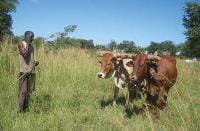As you can see by our feature on animal loan schemes, running an animal loan scheme can be a rewarding but challenging experience. So to help you, Footsteps asked five organisations across the world to share their experiences with our readers. Many thanks to the following Tearfund partners:
- Brethren in Christ Church (Zambia)
- Myanmar Baptist Convention
- EAGLES (Malawi)
- Livingstonia Development Department (Malawi)
Why did you start an animal loan scheme?
‘Many farmers in the Southern Province of Zambia (where the Brethren in Christ Church works) rely on cattle as a source of traction, as well as for meat and dairy products. Unfortunately herds were severely depleted by corridor disease (a form of East Coast fever transmitted by ticks) during the 1990s. The great loss of cattle meant they were in high demand, which in turn led to unusually high cattle prices. This made it very difficult or impossible for the rural poor to have cattle, prompting us to help people in this area of great need.’
Brethren in Christ Church, Zambia
Whom did you select to receive animals and why?
‘Normally beneficiaries are poor families with school-aged children, widows and female-headed households. We also look for those who have experience and resources available for raising livestock (time, space, etc). A Village Livestock Committee, formed at the start of the programme, chooses the beneficiaries.’
Myanmar Baptist Convention
‘The community selected the poor who are infected with or directly affected by HIV and AIDS to receive two cows on loan.’
Brethren in Christ Church, Zambia
‘The beneficiaries are identified at a community meeting where everyone is welcome. They are selected according to criteria which identify vulnerable households (eg people living with HIV/AIDS, the elderly, child-headed households etc).
EAGLES, Malawi
What kind of training did people receive?
Beneficiaries are trained in cattle management before they receive animals. Special training on basic business management is run to help beneficiaries to conduct their farming business profitably.’ Brethren in Christ Church, Zambia
‘After beneficiaries are selected, experienced people provide training on housing, how to choose an appropriate animal, prevention and treatment of diseases, feed, documentation and marketing.’ Myanmar Baptist Convention
How is the scheme administered? What advice can you give to readers?
‘Repayments can be done in cash or any other form of payment which is easy to change into cash and which is accepted by the community. This money is used to buy more oxen which are given to a new group of beneficiaries. The repayment is done with a low interest rate fixed by the community management committee in consultation with the community. With dairy cows, repayment is done by passing on one offspring per animal received.’ Brethren in Christ Church, Zambia
‘The Village Livestock Committee is key to the success of the project because it supervises and monitors the scheme to avoid poor management and the outbreak of diseases.’ Myanmar Baptist Convention
‘In order to make the process transparent, it is spearheaded by a special committee and by traditional leaders. All the animals are given out in an open place where everybody is invited to witness who gets which animal. All the farmers sign an agreement in the presence of traditional leaders and the livestock committee. Agreeing on a constitution that safeguards the scheme has been vital.’ Livingstonia Development Department, Malawi










